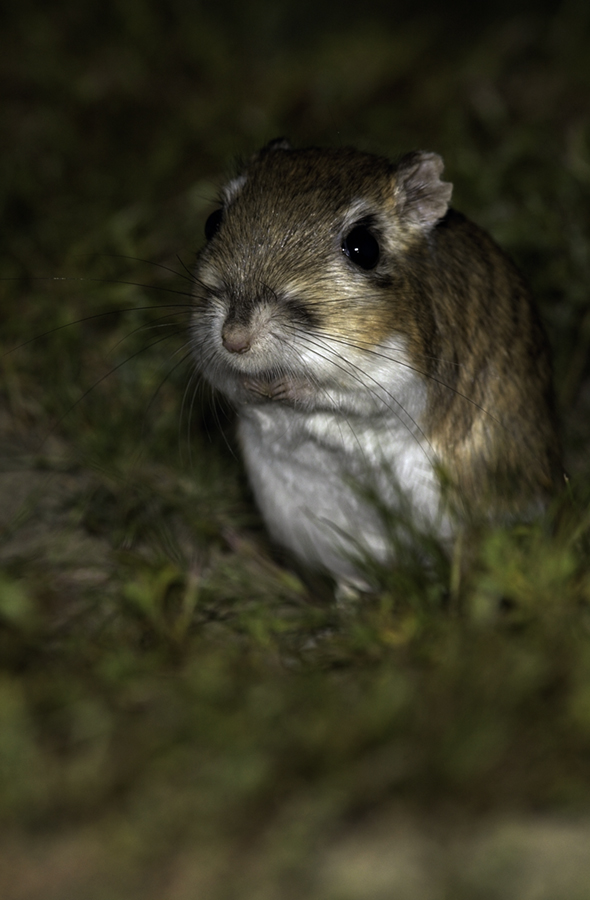|
GIANT
KANGAROO RAT
Dipodomys
ingens
-
Endangered,
federal Endangered Species Act
-
Endangered,
state Endangered Species Act
The endangered giant kangaroo rat is not your
typical household rodent - in fact they are not even
closely related. This small furry mammal bounces
around on its large hind legs, which are also used
for thumping on the ground to communicate with
fellow k-rats. Found near the Los Padres National
Forest and in the Carrizo Plain National Monument,
the giant kangaroo rat is able to survive severe
drought by obtaining all the water it ever needs
from the seeds it collects and stashes in
underground burrows. With more than 98% of its
habitat gone, the giant kangaroo rat continues to be
threatened by agricultural and urban development,
rodenticides, and oil drilling and exploration.

Photo ©
B. Moose Peterson/WRP
Keystone Species of
the Carrizo Plain
The giant kangaroo rat is the keystone species of the Carrizo
Plain, serving as the foundation for the entire ecosystem. If
the kangaroo rat's population drops, it could mean real problems
for other imperiled critters like the San Joaquin kit fox, the
blunt-nosed leopard lizard, and the San Joaquin antelope
squirrel. The giant k-rat's burrows provide shelter for
squirrels and lizards, and they are a favored part of the kit
fox's diet. Without them, the entire ecosystem would go out of
whack. The giant
kangaroo rat was declared a state endangered species in 1980 and
federally-listed as endangered in 1987, after more than 98% of
its habitat was destroyed. Historically, its range included the
whole western edge of the San Joaquin Valley, stretching from
the Tehachapi Mountains to eastern San Luis Obispo County, but
it is now limited to the southwestern edge of the San Joaquin
Valley, including the Carrizo Plain, Elkhorn Plains, Kettleman
Hills, and Cuyama Valley. The primary cause of this habitat loss
was conversion of lands in the San Joaquin Valley to
agriculture. Additionally, the use of rodenticides to control
ground squirrels killed much of the remaining populations of
giant kangaroo rats.
Drummers on the Plain
The giant
kangaroo rat is the largest of some 20 species of kangaroo rats. The giant kangaroo rat measures about 13 inches from
nose to tail when full grown, and this includes a 7 inch long
tail, which has a characteristic tuft of fur on the end, and
weighs a little over 5 ounces. As with other kangaroo rats, the
giant kangaroo rat has large hind legs, which it uses not only
for hopping around but also for communication. Giant kangaroo
rats will often drum the dirt with these hind legs as a warning
of approaching danger and to declare territory. A single
kangaroo rat’s territory stretches around 20 feet in diameter,
and is found within a colony that can consist of thousands of
core areas within a larger territory.
Giant kangaroo rats feed primarily on the seeds of grasses
and shrubs and are most active during the spring, when these
seeds are ripe. The animals remain active year-round, however,
feeding at night, primarily for the first two hours after dark.
Within its individual territory, a giant kangaroo rat will
maintain a number of shallow pits, which it uses to dry seeds
before storing them in their underground burrows, as well as
patches of dirt is uses for “dust baths.” These baths apparently
help the animal maintain good skin and fur condition, and
facilitate marking of its territory. The kangaroo rat will also
maintain several entrances to its burrow, and several
underground compartments, in which it stores its food and bears
young.
Adapted to Survival
After drying its seeds on the surface, the giant kangaroo rat
will move the seeds to its cool, moist, underground burrow,
where they swell with moisture, providing the animals all the
water they ever need—the giant kangaroo rat never has to take a
drink! This ability, and the practice of collecting and storing
a large amount of seeds, allows the kangaroo rat to survive
severe drought for extended periods of time. This is a very
important adaptation for the giant kangaroo rat, as its
grassland and shrubland habitats typically receive less than 15
inches of rain per year, and during the summer daytime
temperatures reach greater than 100 degrees on average. Giant
kangaroo rats are also relatively adaptable to changing food and
population conditions. When food is abundant and population
densities low, females can produce litters of up to 6 young, and
can produce as many as 3 litters per year. Contrarily, when food
is scarce or population densities high, females can produce
fewer young and may only have one litter during the year.
The majority of prime habitat for the giant kangaroo rat is
now found only in areas of the Cuyama Valley and Carrizo Plain.
While the species has not yet been found on Los Padres National
Forest lands, surveys have been limited and about two thousand
acres of potential habitat occur on the forest near the Cuyama
Valley. On National Forest lands, the Forest Service is
currently evaluating whether to conduct additional surveys to
determine if giant kangaroo rats are found on the forest, and
whether or not to reintroduce the species to areas with viable
habitat on forest lands.
Current Threats Meanwhile, the giant kangaroo rat continues to be threatened
by urban and industrial developments, oil and mineral
exploration and extraction, new energy and water conveyance
facilities, and construction of communication and transportation
infrastructures, which destroy giant kangaroo habitat and
further fragment populations. Oil drilling in particular is now
becoming a serious threat to the population of giant kangaroo
rats on the Carrizo Plain, as oil companies recently proposed to
explore for oil in the heart of the national monument.
|

